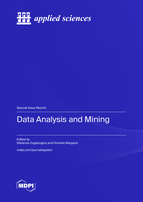Data Analysis and Mining
A special issue of Applied Sciences (ISSN 2076-3417). This special issue belongs to the section "Computing and Artificial Intelligence".
Deadline for manuscript submissions: closed (20 November 2022) | Viewed by 35064
Special Issue Editors
Interests: data mining; machine learning; data reduction; data streams; algorithms and data structures; web
Special Issue Information
Dear Colleagues,
Nowadays, data analysis and mining are being used in numerous everyday tasks to solve practical problems. This research field has attracted the interest of both academia and industry. Therefore, the research community has contributed algorithms, techniques and tools for the prediction of future situations, discovery of clusters with similar data, association rules mining, pattern recognition, etc., all of which are finding applications in many domains, such as medicine, finance, business, biology, marketing, education, etc. This Special Issue is seeking the submission of papers that present new data mining algorithms and techniques as well as applications of data analysis and mining in real-world domains. Moreover, papers that present data mining software tools are also welcomed.
Dr. Stefanos Ougiaroglou
Dr. Dionisis Margaris
Guest Editors
Manuscript Submission Information
Manuscripts should be submitted online at www.mdpi.com by registering and logging in to this website. Once you are registered, click here to go to the submission form. Manuscripts can be submitted until the deadline. All submissions that pass pre-check are peer-reviewed. Accepted papers will be published continuously in the journal (as soon as accepted) and will be listed together on the special issue website. Research articles, review articles as well as short communications are invited. For planned papers, a title and short abstract (about 100 words) can be sent to the Editorial Office for announcement on this website.
Submitted manuscripts should not have been published previously, nor be under consideration for publication elsewhere (except conference proceedings papers). All manuscripts are thoroughly refereed through a single-blind peer-review process. A guide for authors and other relevant information for submission of manuscripts is available on the Instructions for Authors page. Applied Sciences is an international peer-reviewed open access semimonthly journal published by MDPI.
Please visit the Instructions for Authors page before submitting a manuscript. The Article Processing Charge (APC) for publication in this open access journal is 2400 CHF (Swiss Francs). Submitted papers should be well formatted and use good English. Authors may use MDPI's English editing service prior to publication or during author revisions.
Keywords
- data and web mining
- data analytics
- machine learning
- pattern recognition
- data streams
- data reduction
- recommender systems
- association rules
- time series
- data preprocessing
- data cleaning
- feature selection and extraction
- multilabel classification
- neural networks
- data visualization
- tools for data analysis and mining
- applications of data analysis and mining







